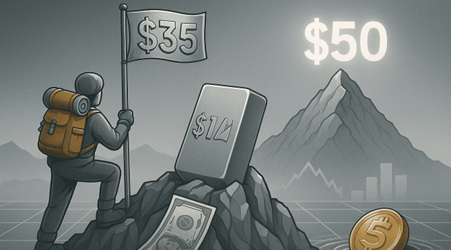The Silver Awakening: When the Quiet Metal Finds Its Voice
Xuan-Ce Wang
6/9/20252 min read


Silver didn't just rally — it tore through 12-year highs while gold stood still.
The markets are whispering something most aren't ready to hear. While headlines chase the latest tech stock or crypto movement, something fundamental is shifting in the precious metals space. And it's not happening where you'd expect.
The Numbers Don't Lie
Comex volumes exploded. Open interest surged. And physical delivery is tightening — fast.
The statistics paint a stark picture: 218 million ounces stood for delivery this year alone. When you step back and look at the available stocks, they barely cover twice that demand. This isn't just increased interest — it's a supply squeeze in real time.
Reading Between the Lines
This isn't just a technical breakout. It's structural stress revealing itself.
Meanwhile, gold remains steady, but not because it's weak. ETF outflows show weak hands are gone. Speculators are selling. And yet gold holds. That's a bullish setup hiding in plain sight.
The gold market is telling a story of patience and underlying strength. When the tourists leave and the metal still holds its ground, that's institutional conviction speaking. But silver? Silver is writing a different narrative entirely.
The Faster Release Valve
Silver is different. It's more liquid. More volatile. And when trust in the paper system cracks, silver becomes the faster release valve.
Think of silver as the canary in the coal mine of monetary metals. Its industrial demand creates a floor, but its monetary properties create a ceiling that can move dramatically when sentiment shifts. The combination makes it uniquely positioned to signal broader market stress before gold makes its move.
A week ago, we said silver wasn't playing second fiddle — it was holding the blade behind the curtain.
Now that blade is moving.
The China Factor
And now add this crucial development: China has stopped supplying physical silver.
The People's Bank of China has managed silver reserves since 1983. Four decades of consistent policy, and now they're pulling back. When the world's largest silver producer decides to keep their metal at home, the West should be paying attention.
This isn't just about supply and demand anymore. It's about strategic positioning. China understands something about the precious metals markets that Western financial institutions are still catching up to.
The Signal in the Noise
If silver leads while gold sleeps, is the market signaling what's next before most are ready to hear it?
The precious metals market has always been a forward-looking indicator of monetary stress and geopolitical tension. But traditionally, gold has been the messenger. When silver takes the lead role, it suggests the message is more urgent than usual.
The combination of technical breakouts, supply constraints, and shifting global dynamics creates a perfect storm. Silver's move through 12-year highs isn't just about price — it's about recognition. Recognition that the financial system's stress points are becoming visible to those willing to look.
What This Means Going Forward
The silver market is telling us something important about the current monetary environment. Physical delivery pressures, reduced Chinese supply, and technical breakouts don't happen in isolation. They happen when underlying fundamentals reach a tipping point.
For investors watching precious metals, silver's leadership suggests we're in the early stages of a broader shift. Gold's patience combined with silver's urgency creates a unique market dynamic that bears close watching.
The blade isn't just moving now — it's cutting through assumptions about how these markets behave and what they're trying to tell us about the road ahead.
The precious metals markets are complex and influenced by numerous factors. This analysis represents observations of current market conditions and should not be considered investment advice.








